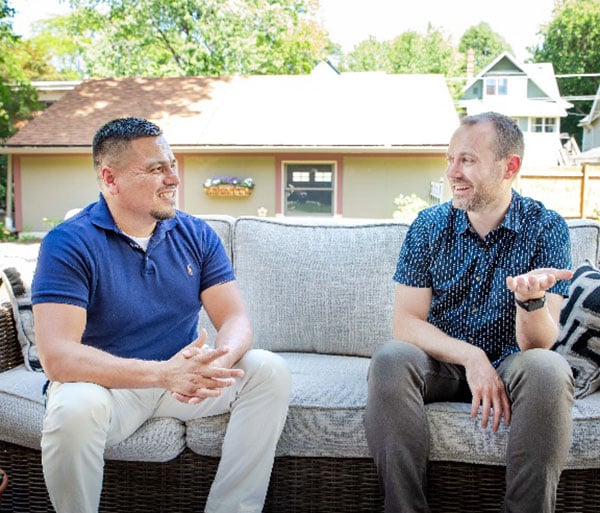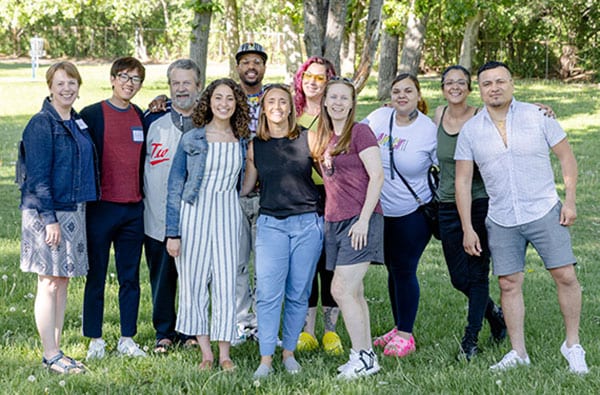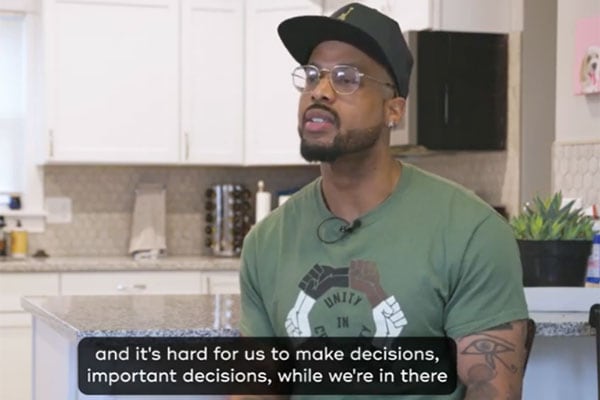Building COVID-19 Vaccine Confidence in Minnesota’s Prisons & Jails

A COVID-19 vaccine conversation with Advisory Board member, Moncies, and Dr. Tyler Winkelman
Among the estimated two million people in U.S. prisons and jails, there have been more than 620,000 reported COVID-19 cases and 2,900 reported COVID-related deaths as of October 3, 2022, according to The COVID Prison Project. “A majority of the largest, single-site outbreaks since the beginning of the pandemic have been in jails and prisons” (COVIDPrisonProject.com). Yet only about 555,500 people who are incarcerated have received at least one COVID-19 vaccine dose.
Those who are incarcerated often have limited or no access to trusted sources of information to help make an informed decision about COVID-19 vaccination. There is also a deep mistrust in the prison system among those incarcerated, related to centuries of oppression, medical racism, and violence. “Prisons are notorious for their sub-par medical care leading incarcerated people not to trust the medical staff,” says Nicole Lewis, Staff Writer for The Marshall Project, a nonpartisan, nonprofit news organization that covers the U.S. criminal justice system.
The University of Minnesota Prevention Research Center (UMN PRC), part of the Centers for Disease Control and Prevention’s PRC Vaccine Confidence Network, developed a community-partnered project to help increase COVID-19 vaccine confidence among those in Minnesota prisons and jails. In partnership with community members impacted by incarceration, the UMN PRC team developed and disseminated to Minnesota prisons and jails five testimonial videos of individuals impacted by incarceration.
In the videos, individuals share their lived experiences of incarceration, concerns they had about COVID-19 vaccines, and reasons they chose to get vaccinated. The goal of the testimonial videos was to share information from trusted messengers with those who are incarcerated to help them make an informed decision about COVID-19 vaccination.
The following were key components of the UMN PRC’s project:
Learn more about the UMN PRC’s project and its Advisory Board members.
- Developed and empowered a project Advisory Board consisting of 14 people with lived experience of incarceration. To share information that motivates and resonates with the incarcerated community, the UMN PRC knew those with lived experience had to lead the way. Drawing on their collective wisdom and strengths, the Advisory Board guided the creation of trauma-informed, culturally tailored strategies aimed at increasing COVID-19 vaccine confidence and uptake among people who are incarcerated.
“The impetus for convening an Advisory Board was based on community-engaged frameworks, community-based participatory research principles, and a general belief that the voices of those directly impacted should be leading the work.”
- The UMN PRC project’s Principal Investigator, Dr. Rebecca Shlafer, was integral to recruiting Advisory Board members. The project team identified individuals through her established relationships with community organizations that serve those impacted by incarceration.
The Advisory Board met from July 2021 through July 2022 for monthly meetings and optional ad-hoc meetings and workgroups. All members were compensated $100 per meeting and $50 per hour to participate in activities, such as reviewing and editing materials, and participating in the video project. Ms. Osman facilitated the Advisory Board and stressed the importance of creating an environment with equal and shared power for sustained actionable involvement among members. She engaged with Advisory Board members throughout the project and focused on meeting them where they were, giving them space to come to the meetings as themselves.

Several advisory board members and project staff at their end-of-year celebration in June 2022.
“We incorporated a lot of principles into the Advisory Board to build trust, including participatory meeting structures and open-agenda meetings that were discussion-based, so members could share their experiences,” said Ms. Osman. She continued, “We focused on accountability, shared power, equity, inclusiveness, transparency, capacity building, and making sure there was mutual benefit for all partners involved. All of this came together to help members feel valued, trusted, and build true relationships, which shined through all aspects of this project.”
- Identified barriers to COVID-19 vaccination by conducting an anonymous survey of people currently incarcerated in three Minnesota prisons and hearing the lived experiences of Advisory Board members. Advisory Board members were key in developing the survey questions and guiding the process of gathering responses. Prominent barriers to COVID-19 vaccination included a lack of trusted sources of information, and lack of access to timely, tailored COVID-19 vaccination information.
- Planned and developed five testimonial videos to provide information to those currently incarcerated and help them make an informed decision about COVID-19 vaccination. Advisory Board members determined that one way to overcome the identified barriers was to share key COVID-19 vaccine information from those who have the same lived experience and are trusted sources of information.


- Shared the videos on YouTube and by coordinating with the Minnesota Department of Corrections (DOC). The UMN PRC engaged with the DOC to get their buy-in and support throughout the project, from the concept phase through video development and dissemination. Shlafer worked with the DOC throughout the project, leveraging her established relationship with them from previous work on other initiatives.
The videos are on YouTube and the Minnesota DOC’s website. They are available with captions and in English, Hmong, and Spanish. The UMN PRC also sent the videos to Minnesota’s 11 state prisons and 85 county jails, requesting them to share the videos with currently incarcerated individuals. All 11 Minnesota prisons shared the videos. As of July 1, 2022, more than 7,800 adults were incarcerated in Minnesota prisons, and a majority have access to viewing the videos, except for those who may be in restricted or special housing.One major challenge that slowed sharing the videos with those who are incarcerated was accommodating facilities’ requests to receive the videos in various formats based on their technology and communication channels, such as DVD or digital file sharing. Some facilities may play the videos in common areas while others may share them via email to view on a tablet.
The UMN PRC’s partnership with community through this Advisory Board structure demonstrated the importance and value of authentically engaging with and investing in those directly impacted by this work.
While this project was funded to focus on COVID-19 vaccination, Advisory Board members raised concerns about many health issues impacting those who are incarcerated. The principles and format employed through this project can be applied to address other health issues impacting this community, demonstrating the value of community-led partnerships in promoting health equity.
COVID-19 Vaccination Strategies Applied by the UMN PRC:
“This work would not be possible without the commitment and dedication of our project Advisory Board members,” said Ms. Osman. “While we were able to convene and facilitate a space for this work, our Advisory Board members were the ones who brought an abundance of wisdom, creativity, and passion day-in and day-out. Our collective successes would not have been possible without them.”